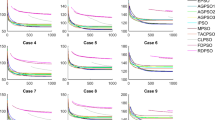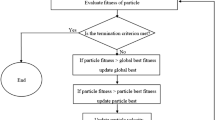Abstract
In order to successfully calibrate a numerical model, multiple criteria should be considered. Multi-objective differential evolution (MODE) and multi-objective particle swarm optimisation (MOPSO) have proved effective in numerous such applications, where most of the techniques relying on the condition of Pareto efficiency to compare different solutions. We describe the performance of two population based search algorithms [nondominated sorting particle swarm optimisation (NSPSO), and nondominated sorting differential evolution (NSDE)] when applied to calibration of a rapid flood spreading model (RFSM). Formulation of an automatic calibration strategy for the RFSM is outline. The simulations show that the both methods possess the ability to find the optimal Pareto front.








Similar content being viewed by others
References
Chen AS, Evans B, Djordjević S, Savić DA (2012) Multi-layered coarse grid modelling in 2D urban flood simulations. J Hydrol 426–427:1–16
Coello Coello CA, Pulido GT, Lechuga MS (2004) Handling multiple objectives with particle swarm optimization. IEEE Trans Evol Comput 8(3):256–279
Cooper VA, Nguyen VTV, Nicell JA (1997) Evaluation of global optimisation methods for conceptual rainfall-runoff model calibration. Water Sci Technol 36(5):53–60
Deb K, Agrawal S, Pratap A, Meyarivan T (2002) A fast elitist non-dominated sorting genetic algorithm for multi-objective optimisation: NSGA-II. IEEE Trans Evol Comput 6(2):182–197
Defra and Agency (2006) The flood risks to people methodology, flood risks to people phase 2. FD2321 Technical Report 1, Wallingford HR et al. did the report for Defra/EA Flood and Coastal Defence R&D Programme
Eberhart R, Shi Y (2000) Comparing inertia weights and constriction factors in particle swarm optimization. In: Proceedings of the 2000 congress on evolutionary computation. Washington, DC, pp 84–88
Guo YF, Keedwell E, Walters G, Khu ST (2007) Hybridizing cellular automata principles and NSGAII for multi-objective design of urban water networks. In: Proceedings of evolutionary multi-criterion optimization, vol 4403, pp 546–559
Janssen PHM, Heuberger PSC (1995) Calibration of process-oriented models. Ecol Model 83:55–66
Kennedy J, Eberhart R (1995) Particle swarm optimisation. In: Proceedings of the IEEE international conference on neural networks, pp 1942–1945
Knowles J, Corne D (2002) On metrics for comparing non-dominated sets. In: Congress on evolutionary computation, pp 711–716
Krupka M, Wallis S, Pender G, Neélz S (2007) Some practical aspects of flood inundation modelling. Transport phenomena in hydraulics, Publications of the Institute of Geophysics, Polish Academy of Sciences. E-7 (401), 129–135
Lhomme J, Sayers P, Gouldby B, Samuels P, Wills M, Mulet-Marti J (2008) Recent development and application of a rapid flood spreading method. River Flow 2008. Oxford, pp 15–24
Liu Y (2009) Automatic calibration of a rainfall-runoff model using a fast and elitist multi-objective particle swarm algorithm. Expert Syst Appl 36(5):9533–9538
Liu Y, Pender G, Neélz S (2009) Improving the performance of fast inundation models using v-support vector regression and particle swarm optimisation. In: 33rd IAHR 2009 Congress, pp 1436–1443
Lorio A, Li X (2004) Solving rotated multi-objective optimization problems using differential evolution. In Webb GI, Yu X (eds) In: Proceedings of the 17th joint Australian conference on artificial intelligence, pp 861–872
Madsen H (2000) Automatic calibration of a conceptual rainfall-runoff model using multiple objectives. J Hydrol 235:276–288
Morris MD (1991) Factorial sampling plans for preliminary computational experiments. Technometrics 33:161–174
Storn R, Price K (1995) Differential evolution: a simple and efficient adaptive scheme for global optimisation over continuous spaces. Technical Report TR-95-012. International Computer Science Institute, Berkley
Sun HJ, Peng CH, Guo JF, Li HS (2009) Non-dominated sorting differential evolution algorithm for multi-objective optimal integrated generation bidding and scheduling. In: IEEE international conference on intelligent computing and intelligent systems, vol 1, pp 372–376
Yapo PO, Gupta HV, Sorooshian S (1998) Multi-objective global optimisation for hydrologic models. J Hydrol 204:83–97
Acknowledgments
The research reported in this paper was conducted as part of the Flood Risk Management Research Consortium. The FRMRC is supported by grant EP/F020511/1 from the Engineering and Physical Sciences Research Council, in partnership with the DEFRA/EA Joint Research Programme on Flood and Coastal Erosion Risk Management, UKWIR, OPW (Ireland) and the Rivers Agency (Northern Ireland). This financial support is gratefully acknowledged.
Author information
Authors and Affiliations
Corresponding author
Rights and permissions
About this article
Cite this article
Liu, Y., Pender, G. Automatic calibration of a rapid flood spreading model using multiobjective optimisations. Soft Comput 17, 713–724 (2013). https://doi.org/10.1007/s00500-012-0944-z
Published:
Issue Date:
DOI: https://doi.org/10.1007/s00500-012-0944-z




